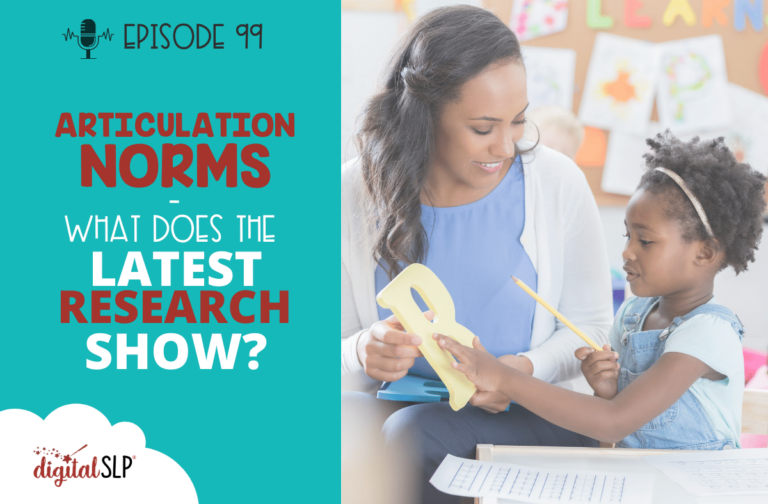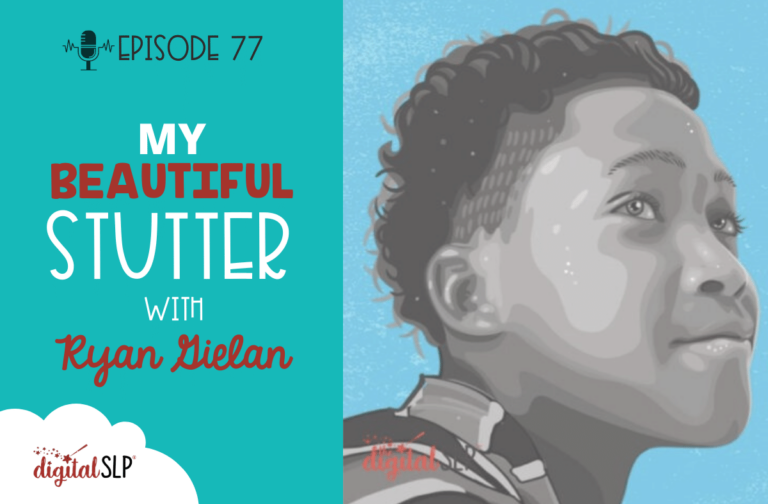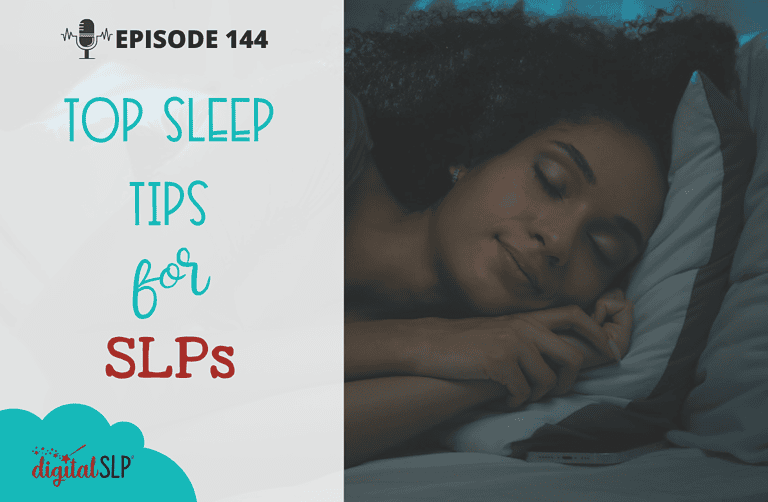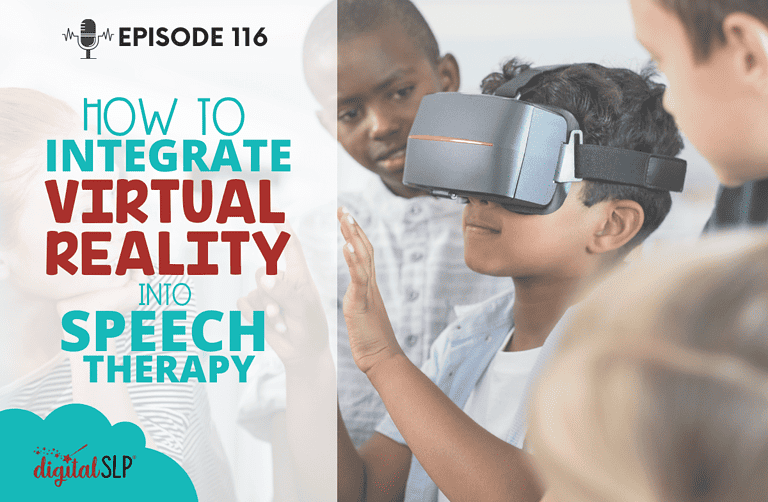In today’s episode, I’ll be discussing the latest research about articulation norms. The topic of research related to articulation norms is one that I think many SLPs have questions about, and it affects many aspects of our profession – from our assessments to our caseload sizes, to the intervention strategies we choose.
Latest research about articulation norms
This topic is important for multiple reasons but it also can be overwhelming. So let’s jump in and figure it out together, as we talk about articulation norms and the latest research. Jessica begins discussing where this “change” came from and comparing McLeod and Crowe’s huge data set vs. SLPs in the schools are required to make treatment eligibility decisions using district criteria that are often drawn from a single study or a much smaller data set.
Even newer research focused on English-speakers from the US
We will also be looking at the latest research that imply that typically developing children master sounds earlier than many of us previously thought and what does this mean for SLPs, and what should we do?
Academic Impact of Speech Sound Disorders
The new research also helps us understand the clinical implications of these findings and that we might need to at least consider qualifying students at younger ages, even if their errors don’t affect many sounds. Research is showing that the stakes are higher than we might have realized for our articulation-only students, and as SLPs, we have the power to positively impact a student’s entire academic career, by identifying and addressing speech sound disorders as early as possible.
This highlights existing workload issue for SLPs and that the constraints districts place on SLPs are very real and can be difficult to change.
Implications for assessment and eligibility
Storkel acknowledges that in reality, school SLPs face a LOT of challenges when they try to update their practice to reflect the latest research. There’s never enough time, and often districts require employees to use outdated guidelines. She offers some great ideas in her article for how to get started with advocating for change, and I encourage you to check it out for more details – the reference will be in the show notes.
References and resources:
- Crowe, K., & McLeod, S. (2020). Children’s English consonant acquisition in the United States: A review. American Journal of Speech-Language Pathology, 29(4), 2155–2169.
- https://doi.org/10.1044/2020_AJSLP-19-00168
- Farquharson, K. (2019). It might not be “just artic”: The case for the single sound error. Perspectives of the ASHA Special Interest Groups, 4(1), 76–84.
- https://doi.org/10.1044/2018_PERS-SIG1-2018-0019
- https://www.asha.org/practice-portal/clinical-topics/articulation-and-phonology/#collapse_6
- https://www.asha.org/siteassets/surveys/2020-schools-survey-slp-caseload.pdf
- https://www.asha.org/siteassets/surveys/2021-slp-hc-survey-caseload-characteristics.pdf
- https://cdn.csu.edu.au/__data/assets/pdf_file/0019/3119104/Treehouse-A4.pdf
- https://www.csu.edu.au/research/multilingual-speech/speech-acquisition
- *This is a GREAT resource with direct open-access links to Crowe and McLeod’s work, and many beautiful infographics to share with families and colleagues.*
- https://www.theinformedslp.com/review/that-one-time-a-journal-article-on-speech-sounds-broke-the-slp-internet
- https://www.theinformedslp.com/review/the-not-new-speech-norms-part-2-an-american-tale
- https://www.slptoolkit.com/blog/we-have-been-interpreting-the-articulation-norms-all-wrong/
- https://speakingmylanguages.blogspot.com/2018/11/childrens-consonant-acquisition.html
- McLeod, S., & Crowe, K. (2018). Children’s consonant acquisition in 27 languages: A cross-linguistic review. American Journal of Speech-Language Pathology, 27(4), 1546–1571.
- https://doi.org/10.1044/2018_AJSLP-17-0100
- Smit, A. B., Hand, L., Freilinger, J. J., Bernthal, J. E., & Bird, A. (1990). The Iowa articulation norms project and its Nebraska replication. Journal of Speech and Hearing Disorders, 55(4), 779–798.
- Storkel, H. L. (2019). Using developmental norms for speech sounds as a means of determining treatment eligibility in schools. Perspectives of the ASHA Special Interest Groups, 4(1), 67–75. https://doi.org/10.1044/2018_PERS-SIG1-2018-0014
- To sign up for a 7-day free trial, please check out: www.thedigitalslp.com/digitalslp
Full Transcript of Podcast: Articulation Norms – What Does the Latest Research Show?
Episode 99: Articulation Norms - What Does the Latest Research Show?
You're listening to the Speech Space Podcast, a podcast full of tips and resources for SLPs. I'm your host, Jessica Cassity, and this is Episode 99.
So today we're going to be talking about the latest research regarding articulation norms. But before we get started, I did want to mention that this podcast is brought to you by The Digital SLP membership site, which is a site that features time-saving interactive digital resources that are all teletherapy platform-friendly. You can learn more or sign up by heading on over to thedigitalslp.com/digitalslp.
The topic of research related to articulation norms is one that I think many SLPs have questions about because it affects many aspects of our profession - from our assessments, to our caseload sizes, and to the intervention strategies that we're choosing.
This topic is important for multiple reasons. In ASHA's 2020 Schools Survey, nearly 89% of the SLPs who responded reported regularly working on articulation. And although SLPs who are in non-school settings might not target articulation as often, in ASHA's 2021 Health Care Survey, 31% of the SLPs who responded reported that articulation is in the top five areas that they target. So this just shows that we all need to know about articulation norms, whatever setting we're working in. It's true that the latest research is probably most relevant for SLPs in the school settings because it may play more of a role in which students qualify for services and at what age they qualify. But we'll talk about that more, later on in this episode!
Another reason why this topic is so important to address is it has caused a lot of confusion and sometimes even stress for SLPs. You might remember that in 2018, a research article came out from Sharryn McLeod and Kathryn Crowe, and it basically made some of our SLP brains explode. We'll get into the specifics from that article in a minute, but the bottom line is that when McLeod and Crowe did a cross-linguistic review of 64 studies related to consonant acquisition, they found that nearly all typically developing children master all consonants by age six, including mastering /r/ by age five. So for many school SLPs, this information definitely didn't align with the qualification criteria that was being used by their districts, where oftentimes you're not even able to address the /r/ sound until students are seven or eight years old.
So this topic definitely has a lot of relevance to our field, but it can also be very overwhelming. So let's just jump in and figure it out together, as we talk about articulation norms and the latest research.
When infographics based on McLeod and Crowe's study started to circulate around social media, many SLPs were panicked. They wondered how this could be possible and worried that somehow we had been doing things wrong all along and, you know, there was a lot of anxiety that maybe caseload numbers would get even larger. Many SLP social media comments were filled with questions like, "What should we do with these new norms?"
So the first thing to remember about the latest research on articulation norms is that the norms really have not changed - we just understand them more fully now. In their article, from McLeod and Crowe, they analyzed the data from 26,007 children in 31 countries speaking 27 different languages. Their huge data set allowed them to really get the "big picture" of sound acquisition.
Now, in contrast, many SLPs in the schools are required to make treatment eligibility decisions using district criteria that are often drawn from a single study or a much smaller data set. For example, some districts are using the Iowa-Nebraska norms, which are based on a study that was done in 1990. Or, some districts ask SLPs to make qualification decisions based on whatever articulation tested is that's available within that district. So that's why McLeod and Crowe's "big-picture" view could definitely feel like a change to many SLPs.
So as the reality of this updated information about sound acquisition started to sink in, SLPs had a lot of questions. One question that came up in the US and other English-speaking countries was related to the fact that McLeod and Crowe's 2018 article included data from children who spoke so many different languages. Some SLPs were wondering if the inclusion of all of those languages had influenced the results.
So, in 2020, Crowe and McLeod released a new paper. Now, this one focus completely on the consonant acquisition of children in the United States. It looked at 15 studies that included a total of 18,907 English-speaking children in the US. And you guessed it - the results from this review were very similar to the ones from the 2018 article. They found that most children mastered most sounds by the age of five! Specifically, plosives, nasals, and glides were mastered by age 3;11, all affricates were mastered by 4;11, all liquids were mastered by age 5;11, and all fricatives were mastered by age 6;11.
When this newer review came out in 2020, it became even more clear: Typically developing children master sounds earlier than many of us previously thought. So our next step is to figure out what does this mean for SLPs and what should we do about it?
The great news is that not only do we have updated research that helps us better understand when children should be mastering specific speech sounds, we also have new research that helps us understand the clinical implications of these findings.
In 2019, Kelly Farquharson, and I hope I'm not butchering that name, she published an article that included case studies and extensive literature review. In that article, she argues that based on the available research, even one persisting speech sound error place a child at risk for difficulty with phonological awareness, literacy, spelling, and/or social emotional wellbeing.
This knowledge, combined with the findings from Crowe and McLeod's 2018 and 2020 articles, shows us that we might need to at least consider qualifying students at younger ages, even if their errors don't affect many sounds. Research is showing that the stakes are higher than we might have realized for our articulation-only students, and as SLPs, we have the power to positively impact a student's entire academic career by identifying and addressing speech sound disorders as early as possible.
Now this probably isn't exactly what any of us want to hear, and I just want to acknowledge that SLP workloads are a huge issue. I also wanna acknowledge that the constraints districts place on SLPs are very real and can be very difficult to change. I love the idea of taking one small positive step in these types of overwhelming situations. Now Dr. Farquharson has a great idea that she mentions. She suggests that we stop using the phrase "just articulation" and then start looking for opportunities to educate families and colleagues about how speech sound disorders are a genuine risk factor for many academic and social challenges.
Now there's another article that dives into the clinical implications of developmental norms, and that was published in 2019 by Holly Storkel. In that article, she analyzes some of the older developmental norm studies that are commonly used in making eligibility decisions, and shares some of the themes that arise from that. She points out that even in older studies, all of the authors recommended against using only developmental norms to make eligibility decisions, and they specifically recommend against using strict age cutoffs. An example of a strict age cutoff would be a school district that doesn't allow students to receive treatment for the /r/ sound until they turn eight years old.
Now Crowe and McLeod emphasized the same points in their 2020 article focused on English consonant acquisition. They refer to Storkel's article in their conclusion, and even quote her when they remind us that developmental norms are "just one piece of the diagnostic puzzle." The clear message from all of these researchers is that we need to look at each student individually and holistically, and use a variety of measures to decide whether or not intervention is warranted. Now this could involve looking at things like spelling and reading, intelligibility, stimulability, social experiences, and parent or teacher input. For SLPs who work in schools, our eligibility decisions are also guided by IDEA, the Individuals with Disabilities Act - but that could be a whole separate podcast episodes, so we're not going to get into that today.
Storkel acknowledges that in reality school SLPs face a lot of challenges when they try to update their practice to reflect the latest research. There's never enough time and often districts require employees to use outdated guidelines. She offers some great ideas in her article for how to get started with advocating for change, and I encourage you to check it out for more details. The link for that will be in the show notes.
Thank you so much for listening to today's episode. I know that was a lot of information, but I really hope that it ultimately was empowering and encouraging and helpful.
If you like today's podcast or found it to be helpful, I would love it if you would take a moment to leave a five-star review to make it easier for your fellow SLPs to find this podcast. I put out new episodes twice a month on the first and third Tuesdays. Also, please don't forget to check out thedigitalslp.com/digitalslp if you are interested in exploring the membership and other resources. Thanks again for listening!













Recent Comments